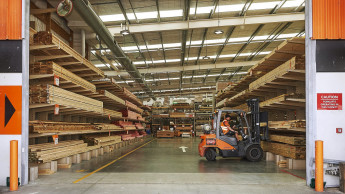B&Q specifies FSC certification to its suppliers, but wants all schemes to focus more on the needs of retailers
When I look at the complexity of the current debates around certification, and the narrowminded passion with which various views are put across, I sometimes think we need to stop and take stock of what we are all trying to achieve. By looking too closely at the detail it is easy to convince ourselves that we all want different things from the same certification processes. And in some ways we do, but there is also a good deal of common ground—when we take the time to recognise it. So let me try to give a buyer’s perspective on certification.
We should start by recognising that timber certification is still a relatively new concept. As recently as 1991, B&Q had no proper information about where its timber was coming from, let alone how it was produced. When a journalist asked how much tropical timber we stocked, alarm bells rang. The more questions we asked of ourselves and of our suppliers, the louder those bells rang. B&Q alone had over 25 different labels on our products – all trying to reassure our customers that our products were from soundly managed forests. They didn’t! The only thing that was going to provide an adequate degree of reassurance, to us as well as to our customers, was a credible, independent certification process. That is why we became so actively involved in the creation of the Forest Stewardship Council (FSC).
Ten years of commercial experience have not changed our view that the FSC is the best of the certification schemes. But no one who knows B&Q (or Kingfisher, the parent company) will be in any doubt about the reasons why we choose to support . Our decision has nothing to do with sentiment or force-of-habit, but is based on the hard commercial reality that the FSC is the scheme that best suits our current needs. Those needs are summed up in our timber-buying policy, which is:
To continue to build our customers’ trust that all our wood and paper products come either from proven, well-managed forests or recycled material, thereby continuing to grow sales and build pride for our entire supply chain.
The FSC provides our customers, our buyers and our suppliers’ buyers with three key elements of reassurance:
the simplicity of one label: none of those groups just mentioned has either the time or the set of skills needed to judge the different labels;
a label that delivers high forestry and audit standards: the heartwood of a certification system is the standard, and we believe that the standard delivers on all the issues that our customers expect us to be concerned about; and
a label that has strong support from the environmental NGOs.
We continue to specify timber for all these reasons, even though it limits the freedom of choice we would prefer when searching the world for new products. But that isn’t our biggest problem with certification. The real difficulty is that out of far too many available schemes not one has sufficient product focus.
We buy wood and sell wood products, not forests, and want to see certification schemes demonstrate a much greater awareness of the needs of retailers. This is demonstrated best through the missed opportunity for embracing the certification of post-consumer waste. At B&Q we have had to remove the FSC label from some of our products because the recycled content has become too high. We are using another label, but that leaves our buyers and customers confused as to the best option – a high recycled content or a high good-forestry content! The customer-focused approach must be to embrace both in the same certification scheme.--nextpage--
We also recognise that the is not entirely popular with some sections of the industry, usually on the grounds hat they prefer to work with the Pan European Forest ertification Council (PEFC). This latter scheme is not currently recognised by as an acceptable route for validating timber from well-managed forests. In an ideal world, these two ‘umbrella’ organisations would either merge or come to some agreement about mutual recognition. But neither of those things is going to happen any time soon.
The FSC and PEFC are likely to compete actively with each other for the foreseeable future – and that need not be a bad thing. Bringing the two schemes together would not remove the flaws they both possess. Keeping them apart will foster competition, keep bureaucracy to a minimum and may lead to more of a customer focus in their operations. It is also worth pointing out that the people who are most in favour of mutual recognition are also the people who tend to say that a monopoly would be a bad thing.
Apart from the two ‘umbrella’ schemes there is a mass of individual certification schemes, with a spectrum of standards and audit procedures. This is unfortunate, unproductive and confusing, but mainly for companies that have not taken a clear strategic decision about why they are seeking certified timber in the first place. Those who want certification for its own sake, rather than to provide specific reassurance on specific points for specific purposes, deserve no sympathy.
B&Q is relaxed about the existence of more than one certification scheme. In 2001, 75 per cent of its timber was certified by the , another 20 per cent was certified by the Finnish scheme and ten per cent could be described as ‘work in progress’. This last category is potentially the most interesting. believes that by working closely with forests that are not -certified but are in the process of gaining certification it will provide commercial incentives for forest certification and secure sustainable sources of timber. For instance, in Vietnam B&Q is working with a company called Scancom, which supplies B&Q with hardwood for garden furniture while running a development program towards certification as members of the Tropical Forest Trust.
At a time when FSC-certified tropical timber is still difficult to obtain, and when companies are under increasing pressure to demonstrate that they are operating responsibly, the TFT scheme and the Certification Support Programme operated by SGS (a certifying company) make good sense and deserve support. In either case there has to be an independently verified action plan driving continuous improvement and leading towards certification.--nextpage--
It is difficult to predict how the market for certification will develop. My suspicion is that the FSC and the PEFC will remain the dominant players, with each gradually achieving distinctive identities and accrediting a range of individual certification schemes. The broad support base of the FSC will make it the stronger brand, based on high standards appropriate to high-profile products and high public awareness. The PEFC, I predict, will find its primary role in less sensitive markets, based on guaranteeing compliance with national standards. There may also be a niche for schemes certifying to even higher standards than the FSC provides, perhaps under the ‘organic’ banner.
B&Q’s vision of making wood from well-managed forests more competitive than wood from poor or unknown forestry deliberately does not specify the means the company will employ to achieve that aim. We will continue to engage in the certification debate and do what we can to influence its course. But we will also work flexibly with whichever schemes seem most likely to help us achieve our real objectives. A ‘perfect’ certification scheme would have the following features:
a clear product focus, making it responsive to the real needs of buyers;
one label, to aid recognition and marketing;
high but realistic standards, covering all the key issues;
buy-in from all stakeholder groups, including positive support from s (because our customers trust their judgement);
strong chain of custody—to maintain credibility and provide reassurance;
reliability unquestioned;
minimal costs; and
accepts recycled timber on equal terms.
It would be interesting to see the lists that other participants in the timber supply chain would come up with. My suspicion is that there would not be many areas of disagreement, which might be a useful first step in acknowledging that we share a common goal – making wood more competitive than other raw materials, so that we actually sell more wood, and all from well-managed forests.












